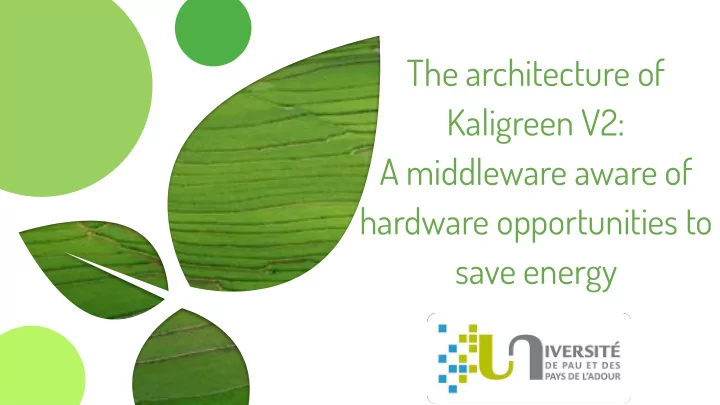

The architecture of Kaligreen V2: A middleware aware of hardware opportunities to save energy
Author Hernán Humberto Álvarez Valera Supervisors Marc Dalmau, Philippe Roose Christina Herzog 2
1. Motivation Shocking data: the reason to worry about energy...
“ ...The data center sector was estimated to have consumed about 61 billion kilowatt/hours (kWh) in 2006 (1.5 percent of total U.S. electricity consumption) for a total electricity cost of about $4.5 billion (2006 dollars). The electricity use of the nation’s servers and data centers in 2006 was more than double the electricity that was estimated to have been consumed for this purpose in 2000. . Electricity demand increases from about 29 billion kWh in 2000 to nearly 73 billion kWh by 2020 ...Consider CO2 emission ... 4
2. how software can save energy ? Let’s talk about load balancing...
6
3. What is our Problem?
“ 8
KALIMUCHO “
“ There is no decentralized way to deploy and manage an application based on microservices through user devices in order so save energy 10
4. So, What is Kaligreen?
It is an autonomic extension of Kalimucho middleware capable of running distributed : applications based on microservices hosted on user devices. Can move/remove/duplicate/change microservices to save energy. CPU, NET HDD
5. Kaligreen V1
RECEIVE μS SEND μS V V V=[CPU,RAM,NET] = = [ [ C C P P U U , , R R A A M M , , N N E E T T ] ]
Implementation... “ 25
Results... “ 26
Kaligreen: Pros and Cons PROS CONS - Scalable - Does not consider device - Increases the execution time of disconnection situations. applications on devices with battery - Does not prevent infinite cyclical and improve battery usage. reconfigurations. - Does not overload the network - Does not study the opportunities of - Decentralized and autonomous. hardware components. - Does not consider the user's actual needs - Does not save energy...
5. Kaligreen V2
Kaligreen is now capable to decide : - How to deploy an application (ie. where to deploy microservices - which host devices) - Considers hardware component offers (will be explained in the next slide). - Kaligreen can decide to move and duplicate microservices to save energy. CPU, NET HDD
Microservice Features CPU features Persistent High CPU Boosting PCPG DVFS Microservice Consumption Boosting, NO YES Candidate Candidate Candidate PCPG, FVFS! NO NO -- -- -- YES YES Candidate Candidate Candidate YES NO -- Candidate Candidate THE CPU 30
THE NETWORK Microservice Features Network operations Persiste Heavy Use a lot of Bandwidth A lot of dependencies large MS Move MS Duplicate Move MS nt MS with others MS and Data data MS Data MS in device I can save energy YES YES YES YES YES Candidate Candidate -- too: Reduce YES YES YES YES NO Candidate Candidate Candidate power; but it is not YES YES YES NO YES Candidate Candidate -- important at middleware level YES YES YES NO NO Candidate Candidate Candidate YES YES NO YES YES -- Candidate -- YES YES NO YES NO -- Candidate Candidate YES YES NO NO YES Candidate Candidate -- YES YES NO NO NO Candidate Candidate Candidate YES NO YES YES YES Candidate Candidate -- YES NO YES YES NO Candidate Candidate Candidate YES NO YES NO YES Candidate Candidate -- 31
THE HARD DISK Condition Action I can save energy if I’m if Hdd requirements of Application M.S. == Candidate to move (Hdd will be able to turn off off! total load of hard disk now itself) 32
“ 33
“ Then, Kaligreen can order the lists according to CPU, network, disk and overall microservice consumption 34
In this moment, we are working on a “ scheduling algorithm based on P2P, graph theory and statistical approaches 35 Figure donne by Piyush Chauhan and Nitin: Decentralized Scheduling Algorithm for DAG Based Tasks on P2P Grid
Thanks! Time for questions!... 36
Recommend
More recommend